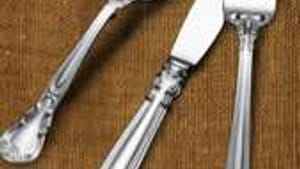Stay in the Loop
BSR publishes on a weekly schedule, with an email newsletter every Wednesday and Thursday morning. There’s no paywall, and subscribing is always free.
Proust had his madeleine, I have my pickle forks
On rediscovering my ancestral silver

Crisis! I'm setting the table for a holiday dinner for ten people and I realize that I have only eight place settings of stainless cutlery.
What to do? Pull out the crappy Wal-mart forks I use for camping? Hardly. My reputation as a Southwestern Martha Stewart wannabe is at stake.
Then, in a monumental "Duh!" moment, I remember that, tucked away on an upper shelf of the pantry, sits a complete set of my parents' Gorham Chantilly sterling: 12 place settings, complete with butter knives and long-handled iced tea spoons. (Yes, iced tea spoons. My parents lived in Alabama.) Not to mention every serving implement in the Gorham catalogue, from pickle fork to punch ladle.
(The former was used to spear— of course— watermelon pickles and the latter to serve my father's lethally alcoholic rum punch.)
From a broken marriage
I had consigned this trove of silver to a top shelf because my present house is Mexican contemporary and my current furnishings are somewhat spare and simple. (It's just a phase I'm going through; my former home was an antique-filled Dutch Colonial.) Since Gorham's Chantilly is practically Baroque— think scrolls, curlicues and rosettes— it isn't what I'd choose to go with my vintage Dansk china, a mid-century modern relic from my first marriage.
But necessity is the mother of improvisation, so I haul down the ancestral silver and lay it out beside the off-white plates rimmed in dark matte brown. And the table looks fabulous.
As I expected, the refined Scandinavian rusticity of the china goes well with the New Mexican centerpiece of grey-green sage twigs interspersed with yellow, orange and red miniature peppers and tiny tea lights. But as I didn't expect, the ornate silver provides a piquant accent, a complementary contrast.
Chapters of my life
So what had kept me from envisioning this possibility? Nothing more than an unexamined assumption that my family's very traditional silver didn't fit into my very contemporary décor.
Unexamined assumptions are often surprisingly revealing when we take a good look at them— and this one, involving tableware of all things, was a case in point. It epitomized the way I've mentally divided my life into eras.
There was my Alabama childhood, mostly happy but constrained by Southern small-town small-mindedness; next, a high-powered Eastern college, intellectually exhilarating but emotionally stressful; and of course that first marriage, which ended necessarily but sadly. It appears that I unconsciously cut my life into chunks and pasted labels onto them.
Memory's dustbin
All of us do this, perhaps to simplify the complexity of memory, but the practice has its drawbacks. Sometimes we consign a "bad" period to our mental dustbin to avoid reliving painful experiences.
In so doing, we may well forget the good bits embedded in it: the moments of insight and humor that offer a counterpoint to suffering; the surfacing of strengths we didn't know we possessed, the random acts of kindness and support we received from others. These are treasures we need to keep, treasures that enrich our lives as we evolve and change.
So, while my ornate family silver is a relic of a limiting subculture I've long since rejected, it's also a link to the unwavering parental love that buffered me from that subculture. And my Dansk china— a wedding gift retained from a romantic but immature marriage— is a souvenir of the sweet early days of its inception, as well as a reminder that this ill-fated union produced the greatest gift of all: two amazing children.
The moral of all this? Edit your past as you edit your possessions. Keep what serves you— which may be more than you think; forgive and forget what holds you back. And try using Aunt Edie's cut crystal sugar and creamer with plates from Ikea. It might just work.♦
To read another writer's approach to throwing stuff out, by Derek Davis, click here.
What to do? Pull out the crappy Wal-mart forks I use for camping? Hardly. My reputation as a Southwestern Martha Stewart wannabe is at stake.
Then, in a monumental "Duh!" moment, I remember that, tucked away on an upper shelf of the pantry, sits a complete set of my parents' Gorham Chantilly sterling: 12 place settings, complete with butter knives and long-handled iced tea spoons. (Yes, iced tea spoons. My parents lived in Alabama.) Not to mention every serving implement in the Gorham catalogue, from pickle fork to punch ladle.
(The former was used to spear— of course— watermelon pickles and the latter to serve my father's lethally alcoholic rum punch.)
From a broken marriage
I had consigned this trove of silver to a top shelf because my present house is Mexican contemporary and my current furnishings are somewhat spare and simple. (It's just a phase I'm going through; my former home was an antique-filled Dutch Colonial.) Since Gorham's Chantilly is practically Baroque— think scrolls, curlicues and rosettes— it isn't what I'd choose to go with my vintage Dansk china, a mid-century modern relic from my first marriage.
But necessity is the mother of improvisation, so I haul down the ancestral silver and lay it out beside the off-white plates rimmed in dark matte brown. And the table looks fabulous.
As I expected, the refined Scandinavian rusticity of the china goes well with the New Mexican centerpiece of grey-green sage twigs interspersed with yellow, orange and red miniature peppers and tiny tea lights. But as I didn't expect, the ornate silver provides a piquant accent, a complementary contrast.
Chapters of my life
So what had kept me from envisioning this possibility? Nothing more than an unexamined assumption that my family's very traditional silver didn't fit into my very contemporary décor.
Unexamined assumptions are often surprisingly revealing when we take a good look at them— and this one, involving tableware of all things, was a case in point. It epitomized the way I've mentally divided my life into eras.
There was my Alabama childhood, mostly happy but constrained by Southern small-town small-mindedness; next, a high-powered Eastern college, intellectually exhilarating but emotionally stressful; and of course that first marriage, which ended necessarily but sadly. It appears that I unconsciously cut my life into chunks and pasted labels onto them.
Memory's dustbin
All of us do this, perhaps to simplify the complexity of memory, but the practice has its drawbacks. Sometimes we consign a "bad" period to our mental dustbin to avoid reliving painful experiences.
In so doing, we may well forget the good bits embedded in it: the moments of insight and humor that offer a counterpoint to suffering; the surfacing of strengths we didn't know we possessed, the random acts of kindness and support we received from others. These are treasures we need to keep, treasures that enrich our lives as we evolve and change.
So, while my ornate family silver is a relic of a limiting subculture I've long since rejected, it's also a link to the unwavering parental love that buffered me from that subculture. And my Dansk china— a wedding gift retained from a romantic but immature marriage— is a souvenir of the sweet early days of its inception, as well as a reminder that this ill-fated union produced the greatest gift of all: two amazing children.
The moral of all this? Edit your past as you edit your possessions. Keep what serves you— which may be more than you think; forgive and forget what holds you back. And try using Aunt Edie's cut crystal sugar and creamer with plates from Ikea. It might just work.♦
To read another writer's approach to throwing stuff out, by Derek Davis, click here.
Sign up for our newsletter
All of the week's new articles, all in one place. Sign up for the free weekly BSR newsletters, and don't miss a conversation.

 Susan E. Washburn
Susan E. Washburn